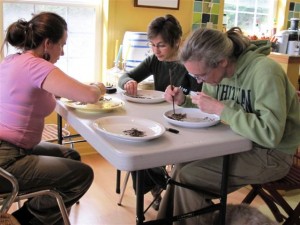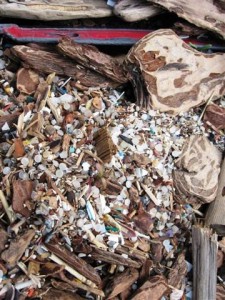Beach Watchers to attend Citizen Science Summit on Plastic Pollution
WSU Beach Watchers, San Juan County, are supporting marine plastic pollution research and education under the guidance of Jen Kingfisher of the Port Townsend Marine Science Center. WSU Beach Watchers from Orcas, Lopez and San Juan Islands, along with other local volunteers, sampled island beaches for marine micro-plastics in April.
Thirty-five beaches in 12 counties around Puget Sound and the Northwest Straits (The Salish Sea) are sampled twice a year over eight days. This year’s results will be presented at the Citizen Science Summit on Plastic Pollution in the Salish Sea at Fort Worden State Park on May 14-15. Samplers from Orcas attending the Summit include Nancy Alboucq, Molly Coxe, Desmond Graves, Kim Secunda, Margot Shaw and Marcia Spees.
Quantities of plastic trash are frequently visible on our beaches, but micro-plastics, meaning pieces 5 millimeters and smaller, are not as obvious to the naked eye. For perspective, a millimeter, more or less, is the thickness of your fingernail.
The Orcas samples were taken from Fishing Bay (Eastsound Waterfront Park) and Crescent Beach. Forty-five liters of beach material were collected at high tide lines from six separate one-meter plots. It was then sorted by size and the natural materials discarded. The remaining human-created debris was sorted by category and painstakingly counted.
Some categories of plastics are: foam, filament, film, fragment, and nurdle. Nurdles are ‘pre-production plastic pellets’ that uncomfortably resemble fish eggs and are used for thousand of plastic products like milk jugs.

Marine micro-plastics Orcas volunteers Kim Secunda, Nancy Alboucq, and Molly Coxe - picking plastic and going blind! Photos courtesy of NancyAlboucq
The results from Fishing Bay were astonishing to the volunteers as well as Kingfisher. Even before the plastics were sorted, Kingfisher commented that Fishing Bay appears to have an extremely high plastic concentration. Once counted, the number of plastic bits between 1 and 5 millimeters for Fishing Bay was over 10,177. The number for Crescent Beach was 300.
Micro-plastics monitoring in the Salish Sea is supported by a consortium including: The Port Townsend Marine Science Center, Northwest Straits, Sea Grant Washington, the Washington State Department of Ecology, WSU Beach Watchers, and citizen volunteers and other benefactors. The Fall sampling will be in October. Volunteer samplers are most welcome! For more info contact Marcia Spees: speesart@centurytel.net.
Crossroads Lecture takes on “The Undiscovered Ocean: The Sea Surface Hidden in Plain View”
Curtis Ebbesmeyer, northwest oceanographer and author of Flotsametrics, will speak at the Orcas Center Crossroads Lecture on May 23rd. Since 1991, Ebbesmeyer has been tracking all sorts of flotsam, including tennis shoes, rubber and plastic toys and other items that spill from ship containers into our oceans. He coined the term “garbage patch” in the 1990’s to describe “vast concentrated repositories of whatever floats on the oceans”.
Additional info:
https://www.ptmsc.org/science/plastics.html
https://www.thegoodhuman.com/2008/10/21/ten-ways-to-reduce-plastic-consumption
**If you are reading theOrcasonian for free, thank your fellow islanders. If you would like to support theOrcasonian CLICK HERE to set your modestly-priced, voluntary subscription. Otherwise, no worries; we’re happy to share with you.**









Thanks for posting this article, Margie. Small correction- the “numerous nurdles” concentration is found at Eastsound Waterfront Park (Fishing Bay), not Crescent Beach. Nurdles were found at Crescent Beach, but not in such abundance.
Plastics start as nurdles (pre-production plastic) and sadly, they end up in our oceans in that form. Check out this video to know more about nurdles. https://youtu.be/57_KdKrJKeM